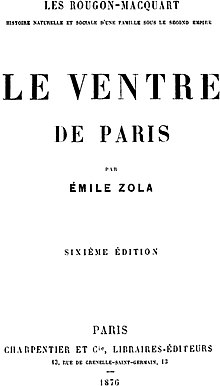Le Ventre de Paris
| Author | Émile Zola |
|---|---|
| Country | France |
| Language | French |
| Series | Les Rougon-Macquart |
| Genre | Novel |
Publication date | 1873 |
Published in English | 1888 |
| Preceded by | Une page d'amour |
| Followed by | La joie de vivre |

Le Ventre de Paris [lə vɑ̃tʁ də paʁi] (1873) is the third novel in Émile Zola's twenty-volume series Les Rougon-Macquart. It is set in and around Les Halles, the enormous, busy central market of 19th-century Paris. Les Halles, rebuilt in cast iron and glass during the Second Empire was a landmark of modernity in the city, the wholesale and retail center of a thriving food industry. Le Ventre de Paris (translated into English under many variant titles but literally meaning The Belly of Paris) is Zola's first novel entirely on the working class.
The protagonist is Florent, an escaped
Although Zola had yet to hone his mastery of working-class speech and idioms displayed to such good effect in . It is an interesting and often powerful work, though not usually considered as being on a par with the novelist's achievements later in the Rougon-Macquart cycle.
Translations
Le ventre de Paris was originally translated into English by
- La Belle Lisa or The Paris Market Girls (1882, tr. Mary Neal Sherwood, T. B. Peterson Bros.)
- The Fat and the Thin (1888, tr. unknown for H. Vizetelly, Vizetelly & Co.)
- The Fat and the Thin (1896, tr. E. A. Vizetelly, Chatto & Windus)
- Savage Paris (1955, tr. David Hughes & Marie-Jacqueline Mason, Elek Books)
- The Belly of Paris (2007, tr. Brian Nelson, Oxford University Press)[1]
- The Belly of Paris (2009, tr. Mark Kurlansky, Modern Library)[2]
References
- ISBN 978-0-19-280633-8(2008)
- ISBN 978-0-8129-7422-5(2009)
External links
- Le Ventre de Paris at Project Gutenberg (French)
- The Fat and the Thin at Project Gutenberg (English)
- (in French) Le Ventre de Paris, audio version

